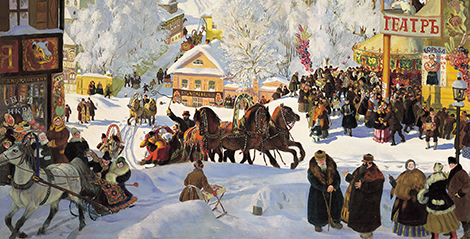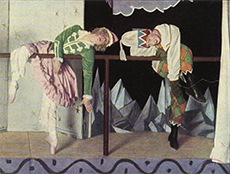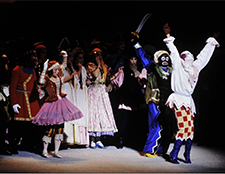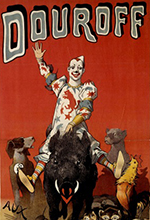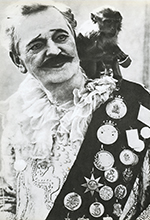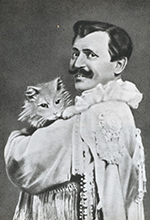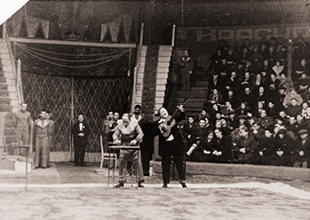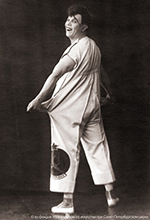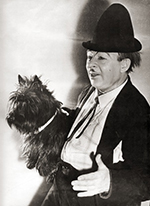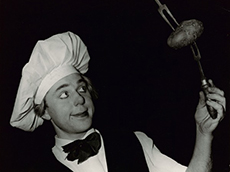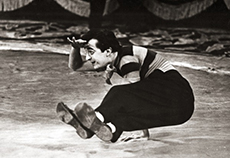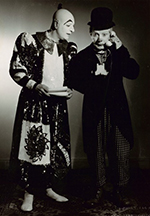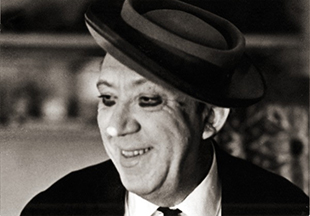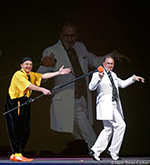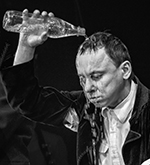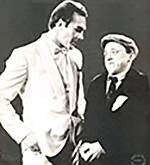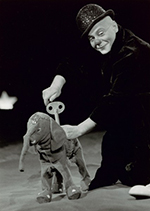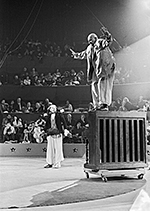by Pascal Jacob
There is a part of jubilation in every society. Collective celebrations are part of this occasional elation where laughter, joy and the pleasure of being together flourish. In Russia, since the 2nd century CE, Maslenitsa, a heliocentric celebration, has been celebrating the imminent end of winter and takes place in the week before the Great Lent. This singular moment is an opportunity to offer the inhabitants of towns and villages a joyful and liberating break and this suspended, light and friendly time encourages the presence within the community of street artists and entertainers.
Entertainers, agitators, ambassadors
Igor Stravinsky places the opening of his ballet Petrouchka at the heart of a fair held on the occasion of Maslenitsa. The setting, designed by Alexandre Benois for the creation of the ballet in June 1911 at the Théâtre du Châtelet in Paris, is structured by huts and stands where saltimbanques perform. Petrouchka, a nickname for Piotr, like Pierrot is for Pierre in French, is a character from the rayok, a puppet theatre whose origins date back to the 17th century. He is a buffoon, with a long nose, wearing a red tricorn, inspired by the figure of Pietro-Mira Pedrillo, an Italian buffoon at the court of Anna of Russia. Stravinsky plays with this filiation and creates a very specific chord, conceived as a leitmotif, to announce the central character of the work. Composed of two augmented thirds, the chord contains the terrifying "triton", a three-tone gap between two notes, feared in musical composition since the emergence of music noted and designated as the mark of the Devil in the Middle Ages (Diabolus in Musica)... This diabolical chord creates a troubling analogy with the character Arlequin, also a comedic figure shrouded in sulphur. A buffoon who has become a dancer, Petrouchka is not a clown, but his appearance, hat, necklace and bells, nevertheless refers to those of familiar silhouettes on trestles and rings in the 19th century. Russian and close to the hearts of the spectators, he somehow lays the foundations for the future generations of clowns and Augustes from this gigantic territory.
![]() listen to excerpts from the music of the ballet Petrouchka:
listen to excerpts from the music of the ballet Petrouchka:
– 1947 arranged version on Gallica
– work sheet and excerpts on the website of the Philarmonie de Paris
From the balagan to the ring
The Russian fairground tradition is supported, in particular, by the balagans: a term with multiple linguistic origins, but which here refers both to a fairground hut with a small balcony on the façade and to the entrepreneur who runs it. Allegorically, balagan means chaos, confusion, disorder and by extension farce and fair. Thus, between the antics of Petrouchka and the trestles of the balagan, a fertile ground is created to encourage the emergence of singular characters, sometimes protesters, but undeniably popular. The Durov brothers, Anatoli (1864-1916) and Vladimir (1863-1934) embody this first generation of specifically Russian clowns, but who are influenced by foreign artists such as the Italian acrobat Angelo Briatore. They structure their respective careers based on the training of domestic or wild animals, docile partners who allow them to caricature the society of their time. As a student in the class of Mr. Sechenov, a neurophysiologist who was interested with Pavlov in animal reflexes, Vladimir developed a real know-how with his residents in the Durov Animal Theatre in Moscow and established the reputation of the dynasty in this field. He abandons the clown's disguise for a more sober outfit, but the humour of his presentations, a mirror of Russian society, helps to associate him with the clown register.
Born in 1872, Ivan Radunsky created the character of the clown Bim in 1891: he worked in a duo with various partners, all identified as Bom. Bim and Bom, with their faces covered in white, base their entrées on virulent and political satire. After having been a member of the Bolshevik party and involved in the futurist movement, Ivan Radunsky, with his partner Stanevsky, mocks the new regime. Arrested in 1918 during a performance by the Cheka services, one of the main structures dedicated to territorial security, Bim and Bom narrowly escaped a scheduled execution and left the country. Back a few years later, they devoted themselves to musical routines. Radunsky worked with several Bom, in 1891 with Felix Cortesi, a native Italian naturalised Russian, then with Mieszyslav Stanevsky, a Pole, Vilczak, an accomplished musician, with a remarkable acrobat, Vitali Lazarenko and from 1941 to 1946 with A. P. Kamsky.
Born in 1890, Vitali Lazarenko made his debut at the Nikitin brothers' circus in Moscow in 1911. A prodigious jumper, he jumps a somersault over three elephants in front of Pathé's cameras, but he also creates the character of a vagrant philosopher, famous for his political monologues. Between 1919 and 1921, Lazarenko performed with brigades of actors, the equivalent of the Army Theatre, taking his "troops" to the front. After the nationalisation of circuses and theatres in 1919, it was William Truzzi who was appointed director of the state circus in 1921. It was under his guidance that Vitali Lazarenko performed in the ring of the Old Moscow Circus and established a reputation that extended far beyond the confines of the ring. A theatre and film actor, he joined the avant-garde theatre movement led by Vladimir Mayakovsky and Vsevolod Meyerhold and performed on stage until his death in 1939.
![]() listen to Bim and Bom sketches (in Russian) via the Speech Archive (Archives de la Parole) :
listen to Bim and Bom sketches (in Russian) via the Speech Archive (Archives de la Parole) :
– Arithmetics and Before and Now
– Everything depends on education and Dreams
Augustes and reprises
The permanent circus built on Flowers Boulevard in Moscow by the German Salamonsky in 1880 and the one built on the banks of the Fontanka Canal in St. Petersburg by the Milanese Gaetano Ciniselli in 1877, which became state property, are responsible for creating shows. They rely, as best they can, on a very limited pool of artists and try to acquire an artistic identity. Boris Viatkin (1913-1994), a young clown attached in particular to the Leningrad circus, plays with make-up and a Chaplinesque look to perform as an accomplished wire artist. He is accompanied by his dog Maniuna and walks in the ring with a giant spoon on his shoulder, an allegory of Harlequin's unquenchable hunger, always ready to dip his own wooden spoon into a forgotten pot... Viatkin wears a brown striped suit, which is both elegant and smart…
Following the establishment of the state circus and with a view to renewing artistic forms, the government created the Moscow School of Circus and Stage Art in 1927. A young artist, Mikhail Rumyantsev, was part of the first class three years later. Acrobat and clown, he "found" his artistic identity in 1936. From now on, he performs as the clown Karandach, or Caran d'Ache, "pencil" in Russian, because he usually highlights with a stroke of... pencil the most important current events in the daily press to feed his evening entrées in the ring. Accompanied by a small dog named Kliaksa, "ink stain", Karandach became a real star in the Soviet Union and beyond. He performed in Paris in 1958.
A skilled teacher, Mikhail Rumyantsev's pupils in the 1950s were Oleg Popov, Yuri Nikulin and Mikhail Shuidin. Today the Moscow Circus Art School bears his name. The latter two, born respectively in 1921 and 1922, partners from 1950, will embody the next generation and also mark a turning point in the evolution of clowning in the Soviet Union. Yuri Nikulin, a slender silhouette and an extraordinarily expressive face, is adored by the audience and is developing an important film career on the sidelines as well.
Yuri Nikulin (1921-1997) and Mikhail Shuidin (1922-1983) developed their repertoire according to their obligations in the ring: evening Augustes or reprises Augustes, they created in particular the parody of the riders and transformed a simple reprise performed after an elegant duo of riders into a real comic entrée. They exploit with talent and success a parodic vein, mirroring the prowess of the troupe. Nikulin, who has always or almost always written jokes and good words heard at random from his encounters in a small notebook, founded The White Parrot Club, a television show where celebrities exchange jokes around a table. A celebrated artist, he took over the management of the Old Moscow Circus, Salamonsky's building, in 1983, and led its total refurbishment between 1985 and 1989. The circus has been named after him since 1996 and a bronze statue of the clown is installed at the foot of the building.
New generations
Paradoxically, Oleg Popov (1931-2016) and Leonid Enguibarov (1935-1972), two young clowns who started their careers in 1949 and 1959 respectively, developed fundamentally different styles. If Karandach was undoubtedly inspired by Charlie Chaplin's Charlot's silhouette, Leonid Enguibarov claims more of a filiation with Marcel Marceau. The French mime toured the Soviet Union in the 1960s and shook up many artists with the sheer purity of his playing. Enguibarov, a boxer and mime of Armenian origin, transcends the figure of the clown and creates a silent character, a mercurial Auguste who is admired by Yuri Nikulin for his ability to philosophise about the existence and fragility of the world without saying a single word, playing with unique physical abilities and imbued with a joyful melancholy. In 1971, Leonid Enguibarov left the ring to create a solo theatrical show, based on his reprises. He started a tour throughout the Soviet Union before dying prematurely the following year.
While Karandach, Viatkin, Nikulin or Shuidin are quite similar in terms of silhouettes to some European figures such as Rum or Beby, Oleg Popov stands out by a more offbeat, perhaps more caricatural appearance, marked in particular by the use of a more intense make-up than his predecessors and especially by the presence of a red nose. Popov is endearing, innovative also for the Soviet public who consider him as a joyful blast of clowning. Auguste specialised in the reprise, he plays the veterinarian, checks on a sick lion and ends up going off the ring arm in arm with the beast, a dummy, of course. He disguises himself as an opera diva, a silhouette close to that created by Charlie Rivel in 1973, owns a dog and a rooster, emerges as a talented wire artist, juggles, participates in collective buffooneries where he plays a contortionist to laugh in the midst of a crowd of extras. Oleg Popov was part of the first tour of the Moscow Circus in France in 1956, two years before Karandach, his teacher... Golden Clown at the International Circus Festival of Monte Carlo in 1981, he founded his own circus a few years later by buying the magnificent big top designed for the Nuits du Cirque in 1983. Although he settled in Germany, he died in Russia at the age of 85, in Rostov-on-Don, still performing in the ring and on tour… Born in 1948, trained in Kiev, Anatoly Marchevsky was the transition from Enguibarov to Popov: his hair on his shoulders, dressed in an acid green jersey with orange and purple flowers and "flared" trousers, he played his role as an evening Auguste with malice and fantasy. He conquered the Parisian public in 1976 and, at the end of a distinguished career, took over as director of the Yekaterinburg circus.
From St. Petersburg to Kiev
Born in 1950 in Novossil, Viacheslav Polunin is part of this long clown lineage, but above all he develops a dazzling vision of the clown's place in society. Influenced by the Russian avant-garde, butoh, Chaplin, Marceau and Enguibarov, he founded the Teatr Licedei in Leningrad in 1968 with the actor and clown Vladimir Olshansky. Based in an abandoned abbey until 1995, Teatr Licedei travelled around the world and performed successfully in many festivals. In 1989, the clown collective created the Mir Caravan, the Peace Caravan, a journey in stages, one of the most significant of which is the one in Berlin, at the foot of the Brandenburg Gate. After the break-up of the Soviet Union, the original group disbanded, and its members pursued various artistic adventures. Viacheslav Polunin created the Slava Snowshow in 1993, an evolving show that is constantly reinventing itself as it tours and according to the countries and performers. Subversive and poetic, metaphysical and Beckettian, Polunin's clown is singular and universal: a red nose, eyes and mouth outlined in white and black, his mask recalls the spirit of the American tramp, but also offers him a wonderful signature.
Considered in the heyday of propaganda as a "derisory staining" as opposed to the simple appearance of Soviet clowns, make-up is one of the first lines of division between generations. When Yuri Nikulin defines his character of Yurik with a slight dash of black under his eyes and a shadow of red on his nose, he adopts a very human silhouette, close to his audience, like Karandach or Enguibarov. The second break, which was geopolitical, was the massive arrival of Ukrainian collectives in the early 1990s, such as the Imancipa trio, three young women, or the Koblikovs, and Housch-Ma-Housch, who worked alone. Russian clowns like Mai, Kuklachev, Aleksandrov and Sokolov, Timur and Konstantin or Andrey Jigalov and Eduard Alekseenko seem infinitely classic compared to the exuberance of Group A (Alexander Ananiev, Ivan and Anatol), the KGB, Pavel Boyarinov and Alexei Ivanov, the Mikos or the "young" Licedei who created Semianiky, outrageously blushed and dressed in unstructured or brightly coloured costumes. Like the Kyrgyz Krasky Vostoka collective, all of them are part of this intuitive filiation where derision and parody infuse a creative repertoire that borrows very little from Western recipes.



